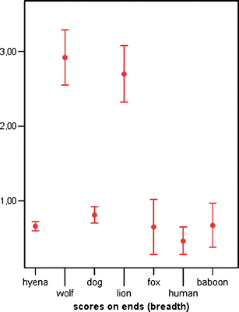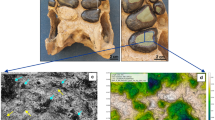Abstract
The use of tooth mark sizes to infer carnivore types when analyzing the modification of faunal assemblages has been criticized on the base of intense overlap in tooth mark size among differently sized carnivores. The present study analyzes this overlap and presents some critical explanations for it. This work is based on the largest collection of tooth pit dimensional data collected to date for some of the most relevant carnivore types. The study empirically shows that small and large carnivores can be clearly differentiated when using tooth pit size, with a higher discrimination when using tooth marks on dense shafts than on cancellous ends. It is argued that most previous studies of tooth mark sizes have reproduced a higher overlap probably because sample sizes were small, and experiments were carried out using small carcasses (which require a smaller bite force) or for a combination of factors.







Similar content being viewed by others
References
Andrews P, Fernández-Jalvo Y (1997) Surface modifications of the Sima de los Huesos fossil humans. J Hum Evol 33:191–217
Binford LR (1981) Bones: ancient men, modern myths. Academic Press, New York
Blumenschine RJ (1986) Early hominid scavenging opportunities. Implications of carcass availability in the Serengueti and Ngorongoro ecosystems. BAR International Series 283. BAR International, Oxford
Blumenschine RJ (1988) An experimental model of the timing of hominid and carnivore influence on archaeological bone assemblages. J Archaeol Sci 15:483–502
Blumenschine RJ (1995) Percussion marks, tooth marks and the experimental determinations of the timing of hominin and carnivore access to long bones at FLK Zinjanthropus, Olduvai Gorge, Tanzania. J Hum Evol 29:21–51
Borrero LA, Martin FM, Vargas J (2005) Tafonomía de la interacción entre pumas y guanacos en el Parque Nacional Torres del Paine, Chile. Magallania 33:95–114
Brain CK (1981) The hunters or the hunted? University of Chicago Press, Chicago
Bunn HT (1982) Meat-eating and human evolution: studies on the diet and subsistence patterns of Plio-Pleistocene hominins in East Africa. Ph.D. dissertation. University of California, Berkeley
Cavallo JA (1998) A re-examination of Isaac’s central-place foraging hypothesis. Ph.D. dissertation, Anthropology Department, Rutgers, New Brunswick, NJ
Cavallo JA, Blumenschine RJ (1989) Tree-stored leopard kills: expanding the hominid scavenging niche. J Hum Evol 18(4):393–399
Delaney-Rivera C, Plummer TW, Hodgson JA, Forrest F, Hertel F, Oliver JS (2009) Pits and pitfalls: taxonomic variability and patterning in tooth mark dimensions. J Archaeol Sci 36:2597–2608
Domíguez-Rodrigo M (1999a) Flesh availability and bone modification in carcasses consumed by lions. Paleogeography Paleoclimate Paleoecology 149:373–388
Domíguez-Rodrigo M (1999b) Meat-eating and carcass procurement by hominids at the FLK Zinj 22 site, Olduvai Gorge, Tanzania: a new experimental approach to the old hunting-versus-scavenging debate. In: Ullrich H (ed) Lifestyles and survival strategies in Pliocene and Pleistocene hominids. Edition Archea, Schwelm, pp 89–111
Domínguez-Rodrigo M (1993) La formación de las acumulaciones óseas de macrofauna: Revisión de los criterios de discernimiento de los agentes biológicos no antrópicos desde un enfoque ecológico. Zephyrus 46:03–122
Domínguez-Rodrigo M, Martí R (1996) Estudio etnoarqueológico de un campamento temporal Ndorobo (maasai) en Kulalu (Kenia). Trab Prehist 131:131–144
Domínguez-Rodrigo M, Pickering TR (2010) A multivariate approach for discriminating bone accumulations created by spotted hyenas and leopards: harnessing actualistic data from East and Southern Africa. J Taphonomy 8:155–179
Dominguez-Rodrigo M, Piqueras A (2003) The use of tooth pits to identify carnivore taxa in tooth-marked archaeofaunas and their relevance to reconstruct hominid carcass processing behaviours. J Archaeol Sci 30:1385–1391
Domínguez-Rodrigo M, Serrallonga J, Medina V (1998) Food availability and social stress among captive baboons: referential data for early hominid food transport at sites. l’Anthropologie 36:225–230
Domínguez-Rodrigo M, Barba M, Egeland CP (2007a) Deconstructing Olduvai: a taphonomic study of the Bed I sites. Springer, Dordrecht
Domínguez-Rodrigo M, Egeland CP, Pickering TR (2007b) Equifinality in carnivore tooth marks and the extended concept of archaeological palimpsests: implications for models of passive scavenging of early hominids. In: Pickering TR, Schick K, Toth N (eds) Breathing life into fossils: taphonomic studies in honor of C.K. (Bob) Brain. Stone Age Institute Press, Bloomington, pp 255–288
Estévez EJ, Mamelli L (2000) Muerte en el canal: experiencias bioestratigráficas controladas sobre la acción sustractiva de cánidos. Archaeofauna 9:7–16
Faith JT (2007) Sources of variation in carnivore tooth-marks frequencies in a modern spotted hyena (Crocuta crocuta) den assemblage, Amboseli Park, Kenya. J Archaeol Sci 34(10):1601–1609
Fernández-Jalvo Y, Andrews P (2011) When humans chew bones. J Hum Evol 60:117–123
Hair JF, Anderson RE, Tatham RL, Black WC (1998) Multivariate data analysis. Prentice Hall, New York
Haynes G (1980a) Prey bones and predators. Potential ecologic information from analysis bones of bone site. Ossa 7:75–97
Haynes G (1980b) Evidence of carnivore gnawing on Pleistocene and recent mammalian bones. Paleobiology 6(3):341–351
Haynes G (1982) Utilization and skeletal disturbances of north American prey carcasses. Artic 35:266–281
Haynes G (1983) A guide for differentiating mammalian carnivore taxa responsible for gnaw damage to herbivore limb bones. Paleobiology 9:164–172
Kerbis-Peterhans JC (1990) The role of porcupines, leopards and hyaenas in ungulate carcass dispersal: implications for paleoanthropology. Department of Anthropology, University of Chicago, Chicago
Lewis JP, Traill A (1999) Statistics explained. Addison-Wesley, Harlow
Lloveras L, Moreno-García M, Nadal J (2008) Taphonomic analysis of leporid remains obtained from modern Iberian Lynx (Lynx pardinus) scats. J Archaeol Sci 35:1–13
Mondini M (2000) Tafonomía de abrigos rocosos de la Puna. Formación de conjuntos escatológicos por zorros y sus implicaciones arqueológicas. Archeofauna 9:151–164
Montalvo CI, Pessino ME, Bagatto FC, Montalvo CI (2008) Taphonomy of the bones of rodents consumed by Andean hog-nosed skunks (Conepatus chinga, Carnivora, Mephitidae) in central Argentina. J Archaeol Sci 35:1481–1488
Muñoz AS, Mondini M, Durán V, Gasco A (2008) Los pumas (Puma concolor) como agentes tafonómicos. Análisis actualístico de un sitio de matanza en los Andes de Mendoza, Argentina. Geobios 41:123–131
Nasti A (1996) Predadores, carroñeros y huesos: la acción del puma y el zorro como agentes modificadores de esqueletos de ungulados en la Puna meridional, Argentina. In: Meléndez Hevia G, Blasco Sancho MF, Pérez Urresti I (eds) II Reunión de Tafonomía y Fosilización. Zaragoza, pp 265–269
Pickering TR, Dominguez-Rodrigo M, Egeland CP, Brain CK (2004) Beyond leopards: tooth marks and the contribution of multiple carnivore taxa to the accumulation of the Swartkans Member 3 fossil assemblage. J Hum Evol 46:595–604
Pinto-Llona AC, Andrews PJ, Etxebarría F (2005) Tafonomía y Paleobiología de úrsidos cuaternarios cantábricos. Fundación oso de Asturias, Proaza
Prendergast ME, Domínguez-Rodrigo M (2008) Taphonomic analyses of a hyena den and a natural-death assemblage near Lake Eyasi (Tanzania). J Taphonomy 6(3–4):301–335
Ruiter JD, Berger LR (2000) Leopard as a taphonomic agents in dolomitic caves. Implications for bone accumulations in the hominid bearing deposits of South Africa. J Archaeol Sci 27:665–684
Saladié P, Huguet R, C Díez, Rodríguez-Hidalgo A, Carbonell E (2012) Taphonomic modifications produced by modern brown bears (Ursus arctos). Int J Osteoarchaeol (in press)
Selvaggio MM (1994) Identifying the timing and sequence of hominid and carnivore involvement with Plio-Pleistocene bone assemblages from carnivore tooth marks and stone-tool butchery marks on bone surfaces. Ph.D. dissertation, Rutgers University, New Brunswick
Selvaggio MM, Wilder J (2001) Identifying the involvement of multiple carnivore taxon with archaeological bone assemblages. J Archaeol Sci 28:465–470
Sutcliffe AJ (1973) Caves of the east African Rift Valley. Trans Cave Res Group Great Brit 15:41–65
Wilcox RR (2005) Introduction to robust estimation and hypothesis testing. Elsevier Academic Press, London
Yravedra J, Lagos L, Bárcena F (2011) A taphonomic study of wild wolf (Canis lupus) modification of horse bones in northwestern Spain. J Taphonomy 9:37–66
Acknowledgments
We thank J. Kerbis-Peterhans for having allowed one of us (MDR) access to the Maasai Mara hyena den collection. We thank F. Bárcena for having allowed JY access to the Campelo Montain wolf carcasses and S. Ripoll for carcasses processed by foxes in Ayllón. We are also indebted to two anonymous reviewers for their useful comments on an earlier draft of this paper. We also thank M. Prendergast for her comments and editorial suggestions.
Author information
Authors and Affiliations
Corresponding author
Rights and permissions
About this article
Cite this article
Andrés, M., Gidna, A.O., Yravedra, J. et al. A study of dimensional differences of tooth marks (pits and scores) on bones modified by small and large carnivores. Archaeol Anthropol Sci 4, 209–219 (2012). https://doi.org/10.1007/s12520-012-0093-4
Received:
Accepted:
Published:
Issue Date:
DOI: https://doi.org/10.1007/s12520-012-0093-4



